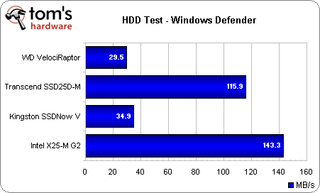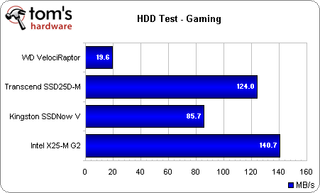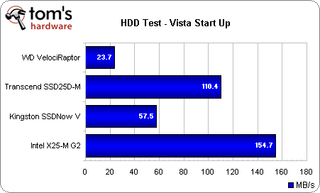Can Bargain SSDs Give Windows A Quantum Performance Leap?
Benchmark Results: PCMark Vantage
For those of you who follow Intel SSDs closely, I’ll throw in an early caveat. Intel assured me that I should be seeing a composite score on the HDD Suite in the 36,000-ish area. My numbers kept landing around 29,000, even after all of the changes and updates. The Vista Startup and Adding Music tests in particular were prone to sub-standard results. As you’ll see, Intel again spanks its rivals, just not by as much as Intel expected.
I also found it interesting that Kingston’s results in this suite changed markedly as I modified the storage drivers and BIOS mode (legacy vs. AHCI)—sometimes better and sometimes worse. You would assume that using the latest software and protocols would yield the highest results. If you have the time, you might want to do some trial and error to see if this is always the case for your drive.
The HDD Suite tests spend 100% of its time looking at disk performance, so there’s no chance for factors such as CPU or GPU hardware to influence the results. Our first two tests in this suite look at disk performance for malware scanning in Windows Defender and data streaming in gaming scenarios. This latter test is important if you play games involving massive environments and/or non-stop action. Both tests depend almost entirely on read operations.


Quite the disparity under Windows Defender. The SSDNow ekes out a win for third place, but it’s clearly the best of two tortoises. Intel and Transcend make turtle soup of their competitors.
Things even out a bit in the gaming test, which examines streaming performance in Alan Wake. I honestly expected a bit more from the VelociRaptor here, but it’s not a bad number—it’s just that the next higher contender, Kingston, pulled in a number that’s 4x better for 50% of the price. Again, Transcend and Intel stand apart.


Here we see the WD drive put in a decent showing when importing pictures into Photo Gallery. Given the rise of photo tagging and increasing need for digital asset management, I like this test quite a bit, so it’s especially good to see a budget SSD perform so well at it. Intel delivers 50% more performance than Kingston, though, and this might become apparent if you do frequent handling of rather large media archives.
The Vista start up test is one of my faves, because, as I said early on, nothing irks me more than waiting for Windows to load (except lima beans; those are terrible). With Intel showing a nearly 3x gain over Kingston here, and over 6x versus WD, keep these numbers in mind when we get to real world boot times and see if synthetics and stopwatch results match up.
Stay on the Cutting Edge
Join the experts who read Tom's Hardware for the inside track on enthusiast PC tech news — and have for over 25 years. We'll send breaking news and in-depth reviews of CPUs, GPUs, AI, maker hardware and more straight to your inbox.
On both of these tests, the workload divides into roughly 85% reads and 15% writes.
Current page: Benchmark Results: PCMark Vantage
Prev Page Benchmark Results: HD Tune Next Page Benchmark Results: PCMark Vantage, Continued-
timbo Dual drive ftw. It especially gives me an important advantage in loading mp maps faster: every second counts in getting to advantageous spots first; it can & does change the outcome of who wins.Reply -
I love how they neglect to include Linux, Unix and Mac. I guess that makes us just less important. By the way I'm pretty sure a SSD would make Ubuntu pretty snappy as well.Reply
-
zebow2002 Linux, Unix and Mac have a combined market share of 30%, wich makes them less important. Great article, can't wait for my Intel G2.Reply -
johnbilicki Two 64GB SSD's in RAID0 is more then enough for most users when a second RAID or bare drive is presumed. The main issue is still the cost per GB at $2-2.5 a GB I'm not knocking any one over even if it halves my boot and application time.Reply
Also in general please stop making socket 1156 like it's the best thing in town because Intel has made it clear that it's a mainstream socket and they will not be getting more then four cores ever; I am only saying this since as an upgrader I hate to see other people presume socket 1156 has a good upgrade path which it doesn't unless Intel changes it's mind and the last time I checked the upgrader's best friend is AMD (good motherboards/chipsets for under $400, unlocked multipliers for under a grand, unlocked cores, etc). -
xrodney I am using now 128GB patriot torx SSD as boot drive (only OS and few apps there leaving half drive not used) and rest apps and media having on 1.5TB 7200rpm drive.Reply
I was really thinking for 3-4 months before jumping on SSD but glad I did. Just 13 min to fully install W7, 15-18 seconds to desktop, 5-8 seconds to shutdown (5 no app running, 8 with loads of them started) and apps starting 3-8 times faster then with regular hdd.
Same as author 1st time booting to OS on SSD almost fell of chair as I was expecting to be it faster but not that much (3.5min boot time before) -
haplo602 wow ... I ma living on an ancient 40GB PATA drive at home. windows and linux and data. I really do not get how your boot drive can be 200GB of application only.Reply
a nice 64GB SSD drive would be just fine for all my needs.
one remark, can you include fakeraid (mobo implemented raid) raid1 configuration tests ? -
xrodney haplo602wow ... I ma living on an ancient 40GB PATA drive at home. windows and linux and data. I really do not get how your boot drive can be 200GB of application only.a nice 64GB SSD drive would be just fine for all my needs.one remark, can you include fakeraid (mobo implemented raid) raid1 configuration tests ?Its not that hard windows 7 64bit alone take like 15GB add hybernation file few apps and you are way over 40GB, some apps or games can have even more then 10GB (AoC have 30GB+).Reply -
Otus Looks like I might need to get a small SSD soon. Since my Ubuntu root (OS+apps) partition has just 4GB of data, I should be more than OK with a 64GB drive. Unfortunately stuffing Windows in there would be almost impossible.Reply -
xrodney SnarkI get the boot drive on desktop angle... but what about laptop installations?On laptop you should even see more performance boost as 2.5" drives they use are usually considerably slower then on desktop. Also you would get rid of possibility damaging disk when dropping your notebook as SSDs have no moving parts.Reply
Most Popular

